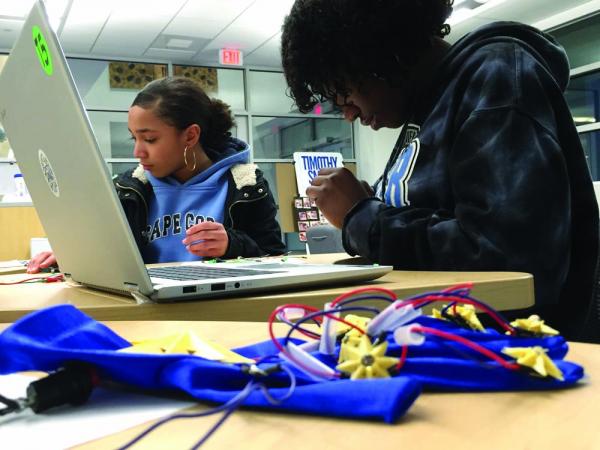June 13, 2019

Boston Design Academy (BDA) participants, Hallie Dubuisson and Linda Baptista of TechBoston Academy, work on the basics of electronics in order to incorporate them into their Final Projects at the Timothy Smith Network (TSN) Lab at the DeWitt Center. Andres Mendez Perez, Mbadika photo
A handful of students from TechBoston Academy participated in the Boston Design Academy (BDA) showcase last month at the Copley Square branch of the Boston Public Library. The students, who range from freshmen to juniors, presented prototypes of high-tech toys they had designed over the course of BDA’s ten-week immersion program.
The after-school course launched its pilot program last summer through a partnership with Boston Public Schools, the Boston Public Library, the tech education non-profit Timothy Smith Network, and Mbadika, a Boston nonprofit that seeks to bridge the access gap between the tech industry and students from underprivileged, underfunded schools.
Netia McCray, founder of Mbadika and Boston Design Academy director, led the students in a bi-weekly workshop based in the branch’s “Teen Central,” an education center equipped with 3D printers, laser cutters, graphic design and modeling software, and other high-tech tools. Using the recent “Avengers: Endgame” film as a theme, McCray helped students transform their ideas for superhero-branded toys into legitimate, functional models.
“The emphasis on technology in movies like Black Panther got students really excited about technology, but we found that a lot of times they heard the technical terms but couldn’t visualize how to make them,” said McCray.
Milton Irving from the Timothy Smith Network, which fully funded the program through a $300,000 grant, said using the Marvel Cinematic Universe was an effective way to make design relatable to teens. “Design is so important, but it’s a little intimidating for a lot of kids. What are things we can do to make it more tangible, more accessible? One way is to infuse popular culture into the teaching process.”
Students used 3D printers and motion sensors to create their toy prototypes, which included a utility belt, a bow and arrow gadget, and a high-tech medical pillow. The program also included a collaboration with NASA, which offered patents and other resources to students for their projects. Participating students also received transportation stipends to cover the cost of travel to and from Copley Square.
McCray, who graduated from MIT, explained that the workshop is all about removing the stigma that only certain people can excel in the tech and engineering fields.
“Kids are afraid of the word engineering; if they use the word ‘design’ they feel more comfortable,” she said in reference to the program name.
“There are so many tech industry jobs in Boston,” she added, “but these kids don’t necessarily have access to them...I tell them about my engineering degree and they say, ‘You don’t look like the mechanical engineers you see on TV.’”
But McCray says the TechBoston students in her program have just as much of a chance to succeed in the tech world as any other kid in the city. “What they don’t realize is how close they are to the step where these products are ready to go to market,” she noted. “The body pillow that [a group of students] designed is actually very similar to a device in production right now, except it’s even more high-tech.”
Irving, too, recognized the potential in both the students’ designs and a more diverse tech industry, stating that the current lack of diversity is costing the country “$400 billion a year. This is truly groundbreaking work. I believe that these kids are the future,” he said.”


